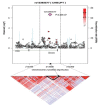A genome-wide association study identifies a breast cancer risk variant in ERBB4 at 2q34: results from the Seoul Breast Cancer Study
- PMID: 22452962
- PMCID: PMC3446390
- DOI: 10.1186/bcr3158
A genome-wide association study identifies a breast cancer risk variant in ERBB4 at 2q34: results from the Seoul Breast Cancer Study
Abstract
Introduction: Although approximately 25 common genetic susceptibility loci have been identified to be independently associated with breast cancer risk through genome-wide association studies (GWAS), the genetic risk variants reported to date only explain a small fraction of the heritability of breast cancer. Furthermore, GWAS-identified loci were primarily identified in women of European descent.
Methods: To evaluate previously identified loci in Korean women and to identify additional novel breast cancer susceptibility variants, we conducted a three-stage GWAS that included 6,322 cases and 5,897 controls.
Results: In the validation study using Stage I of the 2,273 cases and 2,052 controls, seven GWAS-identified loci [5q11.2/MAP3K1 (rs889312 and rs16886165), 5p15.2/ROPN1L (rs1092913), 5q12/MRPS30 (rs7716600), 6q25.1/ESR1 (rs2046210 and rs3734802), 8q24.21 (rs1562430), 10q26.13/FGFR2 (rs10736303), and 16q12.1/TOX3 (rs4784227 and rs3803662)] were significantly associated with breast cancer risk in Korean women (Ptrend < 0.05). To identify additional genetic risk variants, we selected the most promising 17 SNPs in Stage I and replicated these SNPs in 2,052 cases and 2,169 controls (Stage II). Four SNPs were further evaluated in 1,997 cases and 1,676 controls (Stage III). SNP rs13393577 at chromosome 2q34, located in the Epidermal Growth Factor Receptor 4 (ERBB4) gene, showed a consistent association with breast cancer risk with combined odds ratios (95% CI) of 1.53 (1.37-1.70) (combined P for trend = 8.8 × 10-14).
Conclusions: This study shows that seven breast cancer susceptibility loci, which were previously identified in European and/or Chinese populations, could be directly replicated in Korean women. Furthermore, this study provides strong evidence implicating rs13393577 at 2q34 as a new risk variant for breast cancer.
Figures



Similar articles
-
Evaluation of breast cancer susceptibility loci in Chinese women.Cancer Epidemiol Biomarkers Prev. 2010 Sep;19(9):2357-65. doi: 10.1158/1055-9965.EPI-10-0054. Epub 2010 Aug 10. Cancer Epidemiol Biomarkers Prev. 2010. PMID: 20699374 Free PMC article.
-
Relationship between five GWAS-identified single nucleotide polymorphisms and female breast cancer in the Chinese Han population.Tumour Biol. 2016 Jul;37(7):9739-44. doi: 10.1007/s13277-016-4795-6. Epub 2016 Jan 23. Tumour Biol. 2016. PMID: 26803517
-
Comparison of genetic variation of breast cancer susceptibility genes in Chinese and German populations.Eur J Hum Genet. 2013 Nov;21(11):1286-92. doi: 10.1038/ejhg.2013.38. Epub 2013 Mar 13. Eur J Hum Genet. 2013. PMID: 23486537 Free PMC article.
-
Genetic polymorphisms and breast cancer risk: evidence from meta-analyses, pooled analyses, and genome-wide association studies.Breast Cancer Res Treat. 2011 Jun;127(2):309-24. doi: 10.1007/s10549-011-1459-5. Epub 2011 Mar 29. Breast Cancer Res Treat. 2011. PMID: 21445572 Review.
-
[Genome-Wide Association Studies for life-style related diseases].Clin Calcium. 2016 Mar;26(3):419-25. Clin Calcium. 2016. PMID: 26923980 Review. Japanese.
Cited by
-
Supervariants identification for breast cancer.Genet Epidemiol. 2020 Nov;44(8):934-947. doi: 10.1002/gepi.22350. Epub 2020 Aug 17. Genet Epidemiol. 2020. PMID: 32808324 Free PMC article.
-
Evaluation of three polygenic risk score models for the prediction of breast cancer risk in Singapore Chinese.Oncotarget. 2018 Jan 31;9(16):12796-12804. doi: 10.18632/oncotarget.24374. eCollection 2018 Feb 27. Oncotarget. 2018. PMID: 29560110 Free PMC article.
-
Weighted gene co-expression network analysis in identification of metastasis-related genes of lung squamous cell carcinoma based on the Cancer Genome Atlas database.J Thorac Dis. 2017 Jan;9(1):42-53. doi: 10.21037/jtd.2017.01.04. J Thorac Dis. 2017. PMID: 28203405 Free PMC article.
-
Peroxisome proliferator-activated receptor gamma (PPARG) polymorphisms and breast cancer susceptibility: a meta-analysis.Int J Clin Exp Med. 2015 Aug 15;8(8):12226-38. eCollection 2015. Int J Clin Exp Med. 2015. PMID: 26550133 Free PMC article.
-
Association of three single nucleotide polymorphisms of ESR1with breast cancer susceptibility: a meta-analysis.J Biomed Res. 2017 Jan 19;31(3):213-225. doi: 10.7555/JBR.31.20160087. J Biomed Res. 2017. PMID: 28808214 Free PMC article.
References
-
- Ahmed S, Thomas G, Ghoussaini M, Healey CS, Humphreys MK, Platte R, Morrison J, Maranian M, Pooley KA, Luben R, Eccles D, Evans DG, Fletcher O, Johnson N, dos Santos Silva I, Peto J, Stratton MR, Rahman N, Jacobs K, Prentice R, Anderson GL, Rajkovic A, Curb JD, Ziegler RG, Berg CD, Buys SS, McCarty CA, Feigelson HS, Calle EE, Thun MJ. et al.Newly discovered breast cancer susceptibility loci on 3p24 and 17q23.2. Nat Genet. 2009;41:585–590. doi: 10.1038/ng.354. - DOI - PMC - PubMed
-
- Easton DF, Pooley KA, Dunning AM, Pharoah PD, Thompson D, Ballinger DG, Struewing JP, Morrison J, Field H, Luben R, Wareham N, Ahmed S, Healey CS, Bowman R, Meyer KB, Haiman CA, Kolonel LK, Henderson BE, Le Marchand L, Brennan P, Sangrajrang S, Gaborieau V, Odefrey F, Shen CY, Wu PE, Wang HC, Eccles D, Evans DG, Peto J, Fletcher O. et al.Genome-wide association study identifies novel breast cancer susceptibility loci. Nature. 2007;447:1087–1093. doi: 10.1038/nature05887. - DOI - PMC - PubMed
Publication types
MeSH terms
Substances
LinkOut - more resources
Full Text Sources
Medical
Research Materials
Miscellaneous

